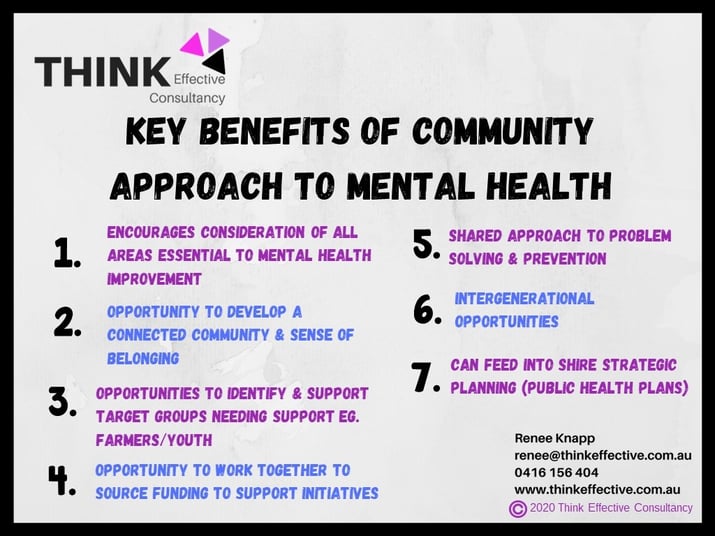Why Adopt a Cross-Sector or Community Approach to Mental Health?
-1.png)
The following article was kindly written and contributed by Renee Knapp, Think Effective Consultancy
You may have read in my last blog post about how I become involved and passionate in a cross-sector approach to mental health (CLICK HERE TO READ).
But WHY do we need this? Why should we consider looking at improvement in mental health across society rather than just within the education system, or for that matter the health system?
As educators we often engage in strategies including prevention, support and intervention in order to improve student mental health. However, we regularly implement incredible strategies at a school level, but find that we get stuck with aspects such as:
- engagement from parents and families
- lack of support services within a local area
- making change happen with issues that exist beyond the school walls that are having an effect on a student’s mental health such as within sporting clubs/social media issues/societal issues
We live in such a busy world these days and mental health has become a significant issue for many people of all ages. So much of what goes on for a student exists outside the school walls, as you can see by the diagram below.

We need to start working together to start addressing ongoing problems and in order to find an effective solution. Within workplaces, local groups, businesses we all address mental health in some way whether it be through a preventative role or a supportive role or in intervention role.
It makes sense that we should work collaboratively in order to create effective solutions to the ongoing issues of suicide and a lack of support services. The challenge is to create an effective process to guide the collaboration so that it becomes a planned approach rather than an incidental collaboration.
Some specific key benefits for adopting a cross-sector approach to mental health include:

-
Consideration of all areas essential to mental health improvement
This includes aspects such as awareness, education, gaps in support pathways, current services available in the local area, opportunities for connection and belonging.
- The opportunity to develop a connected community and sense of belonging
This is a key component for positive mental health and is an essential element that everyone needs. It is important to recognise that this does not look the same for everyone and can come in many different shapes and forms.
- The opportunity to identify and support target groups within the local area (even in an urban setting)
This is a key area for making change happen but it is important to collect real data about what is going on within the community rather than assuming that you already know
- The opportunity to work together to source funding to support key initiatives
Funding is often a great deal more successful when associations work together and have created plans supported by localised groups that outline goals, targets and initiatives.
- Adopting a shared approach to problem solving and prevention
It is not until we put our heads together that we realise how much opportunity exists for us to support one another in similar goals.
- Creates intergenerational opportunities
Creating a community approach allows us to consider the benefits of our younger and older age groups working together. We can build opportunities for varying age groups to share their wisdom in a 2-way street.
- Community approaches to mental health provide the perfect opportunity to feed into strategic shire and local government planning
This is a critical benefit that can help lead to significant long term change if supported and provides benefits for all involved.
Often we discover that so many individuals are doing amazing work within their own association but are not getting any traction. By working together we are able to use the strengths of each association in order to strengthen our approaches. We are able to take into consideration the ongoing issue of stress and overwork that many people are facing and create a process that is beneficial to all sectors including education, health, law enforcement, businesses, shires and local sporting and community groups.
In order to do this we need a system or process that brings people together from different organisations that:
- Is easy to follow
- Has clear processes for communication between organisations
- Has a planned step-by-step approach that is appropriate for the localised environment
- Has achievable outcomes and goals to give the team and community a sense of achievement and value in what they are doing
Over the next few months, I will be guiding you through a process to make this systemic change happen that I believe is highly effective (given my role as a co-founder and Chair or a Community Based Mental Health Action Team).
If you would like to keep up to date with blog posts as they are released, please subscribe to my free newsletter and you will receive a video that outlines the benefits and development of a cross sector approach to mental health and an implementation checklist to get you started.
Author - Renee Knapp
-1.png?width=225&name=Untitled%20design%20(62)-1.png)
Over the next few months, I will be writing an individual blog on each of the above areas in a step-by-step approach so that you can make this change happen effectively in your own local setting.
If you would like to keep up to date with blog posts as they are released, please subscribe to my free newsletter and you will receive 5 strategies to immediately improve mental health or behaviour initiatives in your school.



